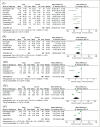Effect of Yoga and Walking on Glycemic Control for the Management of Type 2 Diabetes: A Systematic Review and Meta-analysis
- PMID: 38045671
- PMCID: PMC10692414
- DOI: 10.15605/jafes.038.02.20
Effect of Yoga and Walking on Glycemic Control for the Management of Type 2 Diabetes: A Systematic Review and Meta-analysis
Abstract
Background: A daily habit of yogic practice or walking, along with an oral hypoglycemic agent (OHA) could be beneficial for better control of type 2 diabetes mellitus (T2DM). We conducted a systematic review and meta-analysis of randomized controlled trials (RCTs) to find out the efficiency of yoga or walking on glycemic control in T2DM.
Methodology: The present systematic review and meta-analysis were completed according to the PRISMA guidelines. The risk of bias in included studies was evaluated, by using the revised Cochrane risk-of-bias tool for randomized trials. Meta-analysis was implemented using RevMan software. Forest plots were used to illustrate the study findings and meta-analysis results.
Results: Sixteen studies were included in this systematic review, where 1820 participants were allocated to one of the following interventions: yoga, walking, and without any regular exercise (control group). Participants were between 17-75 years of age. Compared to the control group, the yoga group had a significant reduction in fasting blood glucose (FBG) by 31.98 mg/dL (95% CI = -47.93 to -16.03), postprandial blood glucose (PPBG) by 25.59 mg/dL (95% CI = -44.00 to -7.18], glycosylated hemoglobin (HbAlc) by 0.73% (95% CI = -1.24 to -0.22), fasting insulin by 7.19 μIU/mL (95% CI = -12.10 to -2.28), and homeostatic model assessment for insulin resistance (HOMA-IR) by 3.87 (95% CI = -8.40 to -0.66). Compared to the control group, the walking group had a significant reduction in FBG by 12.37 mg/dL (95% CI = -20.06 to -4.68) and HbA1c by 0.35% (95% CI = -0.70 to -0.01). Compared to the walking group, the yoga group had a significant reduction in FBG by 12.07 mg/dL (95% CI = -24.34 to - 0.20), HbA1c by 0.20% (95% CI = -0.37 to -0.04), fasting insulin by 10.06 μIU/mL (95% CI = -23.84 to 3.71) and HOMA-IR by 5.97 (95% CI = -16.92 to 4.99).
Conclusions: Yoga or walking with OHA has positive effects on glycemic control. For the management of T2DM, yoga has relatively more significant effects on glycemic control than walking.Review registration number: PROSPERO registration number CRD42022310213.
Keywords: glycemic control; insulin resistance; type 2 diabetes; walking; yoga.
© 2023 Journal of the ASEAN Federation of Endocrine Societies.
Conflict of interest statement
The authors declared no conflict of interest.
Figures




References
-
- Hurtado MD, Vella A. What is type 2 diabetes? Medicine. 2019;47(1): 10–5. 10.1016/j.mpmed.2018.10.010. - DOI
Publication types
MeSH terms
Substances
LinkOut - more resources
Full Text Sources
Medical
